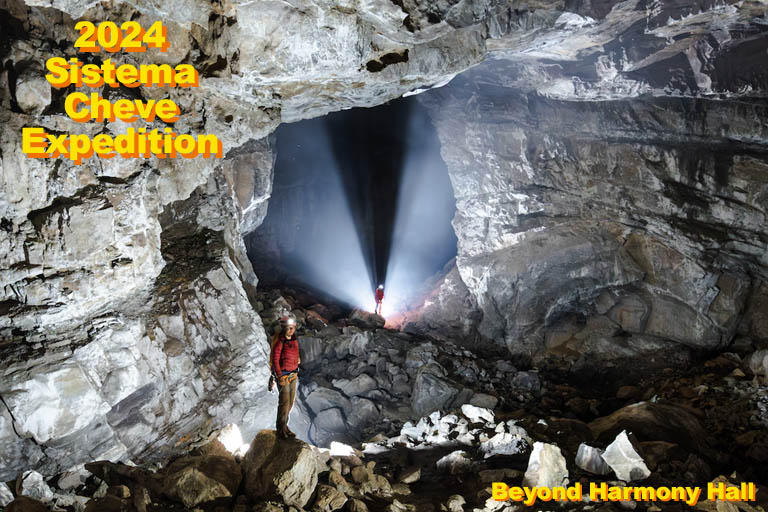 | |
           2026 Sistema Cheve |

2024 Sistema Cheve Expedition
Background The 2023 Cheve expedition effectively represented three independent efforts, which persisted for the entire 6 week duration of the expedition: work from Camp 7B at the far north end of Cheve in an effort to find a way beyond Harmony Hall; pushing deeper in Cueva Palomora (Osto Agua Pajarito); and recon efforts in the general area of San Miguel Santa Flor (SMSF). The results of these three efforts, combined with a new geology map of the area, created an opportunity to make the original entrance of Cheve obsolete and find the way past the end of the cave discovered in 2021. Each of the above efforts made important contributions that factor into the plan for 2024. In 2023 there were three pushes from Camp 7B, set near the Frog Cemetery in the connecting tunnel between the Shining Path borehole and the higher level Chasing Tail tunnel (all at the far northern limits of Cheve). These efforts were initially focused on continuing the ascent of the XEE16 waterfall series that was begun in 2021. It was believed that the source of the XEE16 water is the surface arroyo near SMSF in the middle karst, 1,100 m lower in elevation than the Cheve entrance. The hope was that by scaling the waterfall it might be possible to locate a "back door" entrance to Cheve and eliminate the 5 day transit time from the original entrance to C7B. Instead, a dry paleo labyrinth was discovered leading up, east, and south of the waterfall starting approximately 100 m above C7B. In all, seven kilometers of new cave were discovered in this area in 2023 extending to, in some places, more than 400 m vertically above C7B and reaching within 100 m of the surface. Three passages discovered in 2023 in the paleo labyrinth above C7B are of particular interest. The SLD/SNH survey – up the "Escape Shaft" – comes very close to the surface and may suggest a connection with a new entrance near SMSF. The SNB/SFD/SRB tunnel climbs steadily to the south, gaining more than 225 m in elevation. It appears to be aimed at possible entrances in the upper Aguacate canyon, above the Last Bash entrance to J2. Finally, the SLG/ SLH tunnel, discovered late in the expedition, heads resolutely east and currently reaches a point more than 400 m east of the Shining Path borehole. Importantly, there is strong wind in this passage, blowing outwards. Objectives 1. Cueva Palomora: We plan on a major effort at Cueva Palomora in 2024. We will initially move equipment and food to Camp C3P (-610 m) for a 4 to 6 person lead team to attempt a connection with the hypothesized Peña Negra northern extension borehole. Secondary support teams (either from the surface or operating from camps C1P or C2P) will establish a phone system from the entrance to C3P (and eventually C4P if a suitable place is discovered in large tunnel). In the event that C4P is established in borehole teams of 6 to 8 persons will cycle every 10-14 days for exploration and mapping both upstream (towards the SLG/SLH tunnel in Cheve) and downstream (towards the Charco sump) until the end of the expedition. 2. All in a Days Work (ADW): The initial effort in 2023 will be directed to achieving a connection with Cheve in the paleo labyrinth above Camp 7B. Should this connection be achieved we will immediately direct primary efforts towards establishing Camp 8 in the SLG/SLH tunnel and exploring that eastwards, hopefully to a connection with the hypothesized northern extension of the Peña Negra trunk that would then enable both upstream and downstream exploration and mapping of that trunk. Downstream, presumably, would ultimately lead to a connection with Cueva Palomora and continuing tunnels to the north, towards the Charco sump. There is a possibility that the current limit of exploration in ADW may continue downstream, to the north, without a direct connection to the 2023 paleo labyrinth. In this event, day trips from the SMSF fieldhouse will continue until such time that a suitable site for an underground camp can be located. From that point a supply chain, and phone link, will be established to support lead teams working from that advance camp. 3. Osto Alegria: As time and personnel permit, we will support remote exploration teams (potentially based from the village of Joya Durazno) to establish an underground camp in the labyrinth zone of Cueva Alegria at approximately the -300 m level of the cave and to continue exploration and mapping as deep as possible with the ultimate goal of reaching the Cheve river in the vicinity of the Charco sump. Map data suggest that an additional descent of between 400 to 600 m will likely be needed to accomplish this, but if achieved would allow for exploration both upstream and downstream in the main subterranean river, adding a significant new piece to the overall puzzle of Sistema Cheve. 4. Continued Surface Reconnaissance: In 2023, surface reconnaissance efforts in the upper Aguacate canyon located several promising entrances with outflowing air. At least one tunnel (SNB/SFD/SRB) in the new paleo labyrinth in Cheve discovered in 2023 appears to be heading in this direction. Should a connection be made, this would offer yet another alternative entrance to the deep sections of Cheve. Further work in the SMSF-Joya Durazno corridor is merited as well should Cueva Alegria end. |
| Copyright © 2025 U.S. Deep
Caving Team, Inc. All rights reserved. Todo el contenido tiene derechos de autor del U.S. Deep Caving Team. Todos los derechos reservados. No portion of these pages may be used for any reason without prior written authorization. | |

